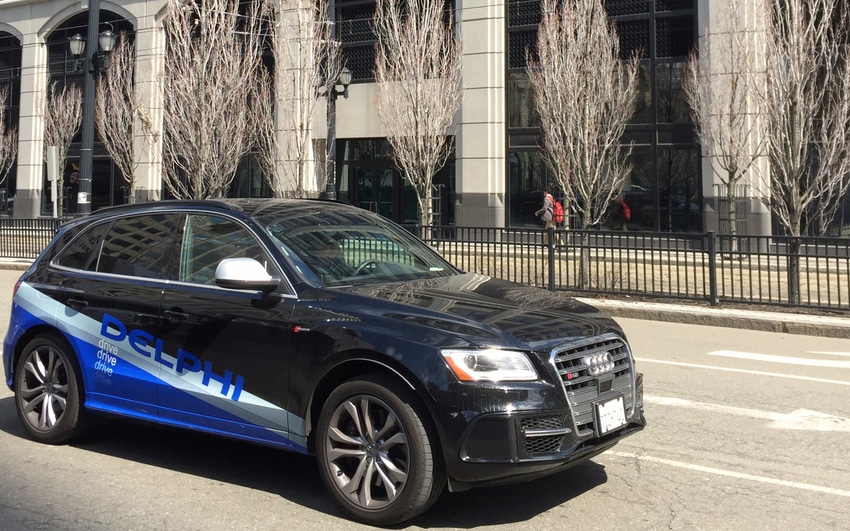Delphi’s Split Should Help the Supplier Polish Its High-Tech Image
The new company, called Aptiv, will focus on electronics, safety, and autonomous car technology.
October 2, 2017

Delphi Automotive’s recent spin-off of its powertrain business was done to enable the supplier to focus on new opportunities, but it also may be a reflection of a growing dilemma for all auto companies – how to profit from traditional technology while satisfying Wall Street’s appetite for high tech.
“It’s very descriptive of the challenge that all traditional automotive players are facing right now,” Brett Smith, program director for the Center for Automotive Research told Design News. “They want to be viewed as something other than an automotive supplier.”
Indeed, Delphi’s well-publicized split enables the company, in part, to do just that. By breaking out its electrical and electronic business and calling it Aptiv, it can focus on such applications as autonomous driving, active safety, and connected services. Meanwhile, its internal combustion engine components business will be a separate entity known as Delphi Technologies.
“The names Aptiv and Delphi Technologies clearly reflect the independent identities, visions and directions of the two companies ...” Kevin Clark, Delphi president and CEO, said in a press release. In an earlier release, Clark also noted that the split “will allow each company to focus even more sharply on its unique opportunities.”
Industry analysts said the split will also make the company’s technology more attractive to investors. “They picked the new name for the electrical architecture and automation business to create the perception of being a new kind of company, a Silicon Valley type of company,” said Sam Abuelsamid, a senior analyst for Navigant Research.
|
In 2015, Delphi incorporated its driverless platform on a vehicle called Roadrunner, which traveled in automated fashion on a nine-day, 3,400-mile journey from San Francisco to New York City. The vehicle was equipped with six long-range radars, four short-range radars, three vision-based cameras, six Lidars, intelligent software algorithms, and Delphi’s Advanced Drive Assistance System. (Source: Delphi Automotive) |
Such strategies are growing more popular with automakers and suppliers, patyly based on evidence supplied by the growth of Tesla, Inc. The upstart automaker has risen to the top of the auto industry in total valuation, even though it lost $889 million in 2015 and $675 million in 2016, and posted a fraction of other automakers’ sales over past few years. The key to its rise has been the popularity of its high-tech image on Wall Street.
Delphi hopes to capture some of the same magic with its split, analysts said. The key difference, however, is that Delphi is starting from a position of business success with both of its two new companies. “Unlike Tesla, Delphi already has a solid business in electrical architectures and ADAS products,” Abuelsamid said. “And it’s going to grow.”
Still, the desire to appeal to potential investors is important to Delphi, analysts said. And the way to do that is to show them the company’s intention to be a high-tech player, especially in the autonomous car market.
“It’s the same story being played out at every supplier and every car company,” Smith said. “Manufacturing auto parts is really uncool. And manufacturing electronics and technology is cool.”
Smith added that need to project a high-tech image is affecting even the most unlikely candidates, including makers or gears, mirrors, and door panels, among other parts. All must burnish their public images by connecting their products to processors, vision systems, and even artificial intelligence, in some cases. Similarly, automakers who profit from old school products, such as trucks, are increasingly publicizing their less-profitable high-tech vehicles as a way of showing they aren’t being left behind.
“Wall Street doesn’t value the old-school products,” Smith said. “It values the idea of new business models.”
Still, the split of Delphi will change little in terms of the day-to-day business in the auto industry, analysts said. Automotive customers who buy products from Delphi today will continue to buy those products, but from two companies instead of one. Similarly, Tier 2 and Tier 3 companies who now sell to Delphi will continue to supply parts, but to two companies, rather than one.
The most prominent effect of the split will likely be seen in the investor community, analysts said. “Delphi’s powertrian business is still strong, but it’s probably not going to be a huge growth business,” Abuelsamid said. “But electrical architectures and automation – that’s where they hope to see the growth in their stock value.”
Senior technical editor Chuck Murray has been writing about technology for 33 years. He joined Design News in 1987, and has covered electronics, automation, fluid power, and auto.
Code Quality Is Key to Securing the Connected Car
Join Jay Thomas, director of field engineering for LDRA, as he discusses the vulnerabilities of connected automobiles at the upcoming
About the Author(s)
You May Also Like


.jpg?width=300&auto=webp&quality=80&disable=upscale)

